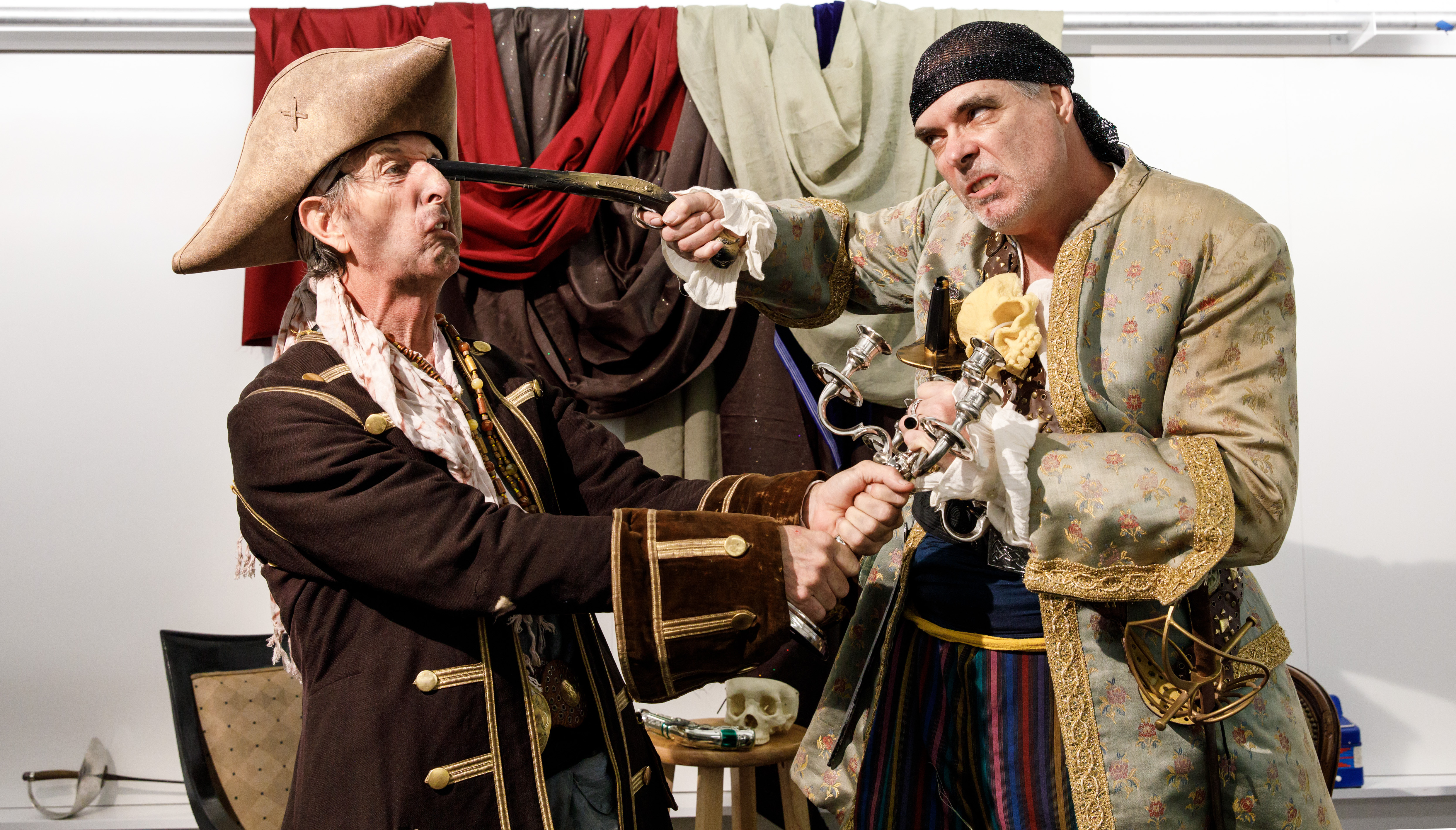This story, written by Solvej Schou and photographed by Juan Posada, first appeared on Dot online.
After downing a cup of coffee, art model John Mackey—wearing a pirate hat and long brown jacket—raises a sword above his head. Next to him, art model Jonnathon Cripple grips a pistol in one hand and a sword in the other, gritting his teeth. You can imagine them shouting “YAAARRRRR!!!!!”
Instead, they’re perfectly still and quiet, facing each other fiercely like Pirates of the Caribbean foes. They stand in front of a packed classroom of students in instructor Will Weston’s Fall 2017 Illustration figure drawing course Inventive Costume.
The students sketch Mackey and Cripple as dynamic swashbuckling characters. In between five, 20 and 25-minute poses, the pair laugh and rest. Weston walks around looking at student work, and gives his expert insight about drawing a figure’s shape, designing a costume and adding folds.
“I tell the students that the models are assuming poses, and that you should change the pose you draw to suit your composition and narrative storytelling,” says Weston, who spent 18 years as an advertising illustrator before going into animation at Walt Disney Animation Studios, Warner Bros., Nickelodeon and Sony, and has taught full-time at ArtCenter for the past decade.
“In here, I’m teaching mechanics,” he adds. “How do you group figures effectively so that the eye can easily make its way through the composition? How does the costume further the storyline?”
Mackey and Cripple—former mimes who have known each other for decades—are two of 90 active art models in ArtCenter’s Model and Prop Department, modeling for academic departments including Illustration, Fine Art, Product Design and Entertainment Design. Besides Inventive Costume, other Illustration courses with art models include instructor Gayle Donahue’s Drawing for Illustration and Jeffrey Smith’s Illustrative Storytelling.
Mackey, who switches mischievously between a Southern and British accent, has modeled at ArtCenter for the past six years, and owns more than 100 costumes. An artist and actor (he appeared in Pirates of the Caribbean: Dead Man’s Chest), some of his campier costumes for Weston’s class have included a priest from the Middle Ages with bloodshot eyes and an alien jester outfit.
“Even though I’m standing still, I’m telling a story. I’m emoting,” Mackey says. “It’s rewarding when students see and draw exactly what I’m thinking. You’re pretending to smoke a cigarette as a detective, and they put a cigarette in your finger. Or they’ll draw blood on the ground, even though there’s no blood.”
Cripple—wearing rainbow striped pants and a teal embroidered pirate jacket—has modeled for 47 years, including at ArtCenter since 2008, and has an undergraduate degree in directing. He once owned and operated a Los Angeles company employing hundreds of actors and actresses for themed events.
His most wacky costume? A Charles Dickens-era rat catcher, complete with a plastic rat named Whitey, Cripple’s self-appointed mascot.
“I use him in almost all of my modeling. He gives me something to work off of as a prop,” says Cripple, grinning. “As a teacher, Will is all about how the artist can get rules and then work with them to create rather than just render. He also understands that as models, we know what we’re doing.”
On a different day in Weston’s class, Illustration student Jacki Li sits front and center—wearing big headphones—as three art models, including Marissa Gomez and Debra Haden, pose for the class in retro burlesque style lingerie.
Gomez, wearing brown lace-up boots and polka dot tights, holds a green fan in one hand, and a martini glass in the other. Haden, wearing a black corset, her bangs curled under like ‘50s pin-up model Bettie Page, points at Gomez angrily. Flowers are strewn on the ground.
“What’s the story, and are you driving the story?” Weston asks the class, lobbing nuggets of advice. “You’re the magician. Don’t have the models be equidistant from each other. Draw them close together or far away. If a hand or arm is not in the right position, move it.”
Li, her hand flying over her paper, sketches a full scene with a curtain draped around the three figures. She aspires to land a job in visual development or storyboarding at Disney, DreamWorks or another studio.
“I love working directly from the models because you can practice so much,” says Li. “You can play a lot with expressions and poses. It’s really about not just depicting the figure as is, but pushing it to be as expressive as possible.”
Haden, who has an undergraduate degree in fashion design, and is also an actress, makes her own costumes and has modeled at ArtCenter since 2010. A fan of the elaborate costumes on RuPaul’s Drag Race, she says she loves to create full characters who express happiness and sadness.
“Sometimes students don’t know how to create a scenario or character,” she says. “If I can provide that inspiration for them to draw from later—‘Oh, I remember that model, I remember her bangs!’—that’s amazing.”
A musician working as an art model at ArtCenter since 2002, Gomez used to be a waitress, and artists would draw her in restaurants. At ArtCenter, her gigs have included being painter Frida Kahlo as a Siamese twin, with another model.
“I’m a very still person, and I don’t have a problem with people staring at me,” says Gomez. “As models, we bring our creativity and our costuming, and it makes it fun for the students, too, this interaction. And because we’re entertainers or performers, we are many selves, so we can be those authentically.”









